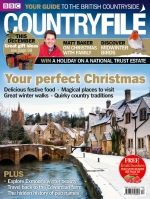Discover the Peak District at Christmas
Like moths around a flame, people slowly gather around the bright lights of the Christmas tree on the village green by the ancient market cross at Great Longstone, in the limestone heart of the Peak District. The talk is in hushed murmurs as the crowd, warmly wrapped-up in hats and scarves, congregate round the cross, stamping their feet against the biting cold. Above them, the stars shine brightly from a satin sky like diamonds strewn across a jeweller’s baize. Then, led by the gentle oompahs of the local brass band, the choir starts the first carol and you know at last that Christmas is here.
There’s something especially magical about a Peakland Christmas. Whether it’s the singing of those old-time traditional carols around the village Christmas tree or – in a unique tradition – in the local pub; a taste of living like a lord by enjoying the splendours of a Chatsworth Christmas; or the last-minute shopping in Peakland villages like Bakewell and Castleton (below), which have been transformed into a fairyland by the Christmas lights; it’s a very special time of the year.
It’s a time when friends and relatives get together, when the past year can be assessed and people look forward with renewed faith and optimism to the next. In a rural area like that of the Peak District, neighbours can sometimes be some distance apart. But this is the time that they get together, take a drink – traditionally the posset cup – and wish each other well for the coming year.
The making of the posset cup was a longstanding tradition of the Peakland Christmas. Although primarily a festive beverage drunk on Christmas Eve, it could also be used as a protection against winter chills and insomnia. The ingredients included boiled milk or cream, ale, eggs, treacle, ginger, nutmeg and other spices. The posset was drunk from specially designed pots, usually made of brown salt glaze ware and embossed with agricultural scenes.
Unique celebrations
A tradition of singing special, purely local Christmas carols still exists in many Peak District and South Yorkshire villages. The singing probably owes its origin to the psalmody of the Georgian period, but these carols are not sung in churches. Instead, the songs are sung outside, as at Longstone, in private houses, but most especially in local pubs. So when you visit, for example, the Old Red Lion at Grenoside or the Miners’ Arms in Eyam, you could well find yourself joining in with an impromptu singalong carol concert with the locals.
William Newton, the Abney-born Minstrel of the Peak, and Richard Furness, a native of Eyam, celebrated every Christmas by writing a carol. Furness wrote the words and music of more than 30, while Samuel Slack, the renowned bass singer of Tideswell, supplied the music for several of Newton’s carols. Some of the carols show the Peaklanders’ typically down-to-earth attitude to life. An example is the Eyam carol, which is entitled T’owd Virgin. The music is attributed to William Knapp, and the words come from old broadsides and chapbooks. The chorus runs: “Then let us be merry, cast sorrow away. Our saviour, Christ Jesus, was born on this day.”
Valuable traditions
Another longstanding Peakland Yuletide tradition was the Christmas Eve candle. The lead miners of Castleton left half a tallow candle burning on the best ore in the mine on Christmas Eve, hoping it would bring good luck the following year. An old book noted: “The miners used to find the best piece of ore they could, stick on it the best candle they could procure, and squat round these on Christmas Eve, singing their old carols until the candle was burnt.”
Bradwell miners left half a candle burning for t’owd man (the spirit of the old miners) and they also left a portion of their dinner. An old Bradwell miner, in his late 80s in the early years of the 20th century, recalled they left the candle: “for the old ancient man to have his posset by.”
At the other end of the social scale, the Duke of Devonshire was renowned for his lavish Christmas celebrations. The 18th-century 5th Duke, William Cavendish, for instance once received a Boxing Day present fit for a king, let alone a duke. His Christmas pie was a complete banquet beneath pastry with turkey, partridge, woodcock, pheasant, plovers, snipe and a whole hare. It not only fed the Duke’s family but went on to fill the bellies of his household too. Christmas spirit was also in good supply around Haddon Hall – the ancestral seat of the Duke of Rutland – with whole oxen and sheep on the spit every day, so that even any beggar could be fed if they happened over the threshold during the festive season.
Such excesses may be a thing of the past, but you can enjoy all the baroque finery of a Christmas at Chatsworth (below) – the Peak’s premier stately home and the palatial seat of the dukes of Devonshire for more than 300 years. Chatsworth’s exclusive Christmas evening openings allow you to visit the Palace of the Peak, beautifully decorated for Christmas, and enjoy a glass of wine and special easonal entertainment. Children can enjoy and be part of the nativity story performed with real animals, throughout December.
Walking wonderland
If it’s the outdoor life that attracts you, the joys of winter walking in the Peak District are unrivalled. However, it’s unusual these days to have a snowfall that lasts over the Christmas holiday period. But sometimes you can be lucky as heavy snow covers the landscape in a brilliant white blanket. The walking, especially on the higher ground like Kinder Scout and Bleaklow, is absolutely spectacular in this weather, as these modest heights put on a passable impression of real Alpine conditions.
They are exactly the sort of conditions that Ernest Baker and his chums in the Kyndwr Club at the turn of the last century would have relished. But their expeditions across the frozen wastes of Kinder had the added frisson of a chance meeting with an abusive, stick-wielding gamekeeper, for at that time these moors were strictly forbidden territory to ramblers. Nowadays, of course, the Countryside and Rights of Way Act has given us the long-cherished freedom to roam, and you can explore at will. As Baker wrote in his classic Moors, Crags and Caves of the High Peak in 1903: “Peakland scenery culminates in Kinder Scout… it has the noblest crags, the biggest peat-moss, and the finest waterfall in the district. Its waters run to the eastern and western seas, the cloughs that penetrate to the heart of it are like mountain corries, with turbulent streams rushing to the dales.
“And Kinder Scout in winter is as wild a place as any mountain in England or Wales. To cross it is no less of an adventure than to cross Scawfell (sic) under like conditions, and the grandeur and novelty of the experience repay one quite as well.”
Peakland weather, however, is never predictable, and many lives have been lost on the moors. Tales of villages cut off by snowdrifts for weeks on end are legend, but perhaps one of the saddest reminders of the severity of the winters in these parts is the memorial in the churchyard at Grindon. In the bitter winter of 1947, an RAF Halifax bomber, bringing emergency supplies to the isolated and cut-off community, crashed nearby, killing all eight crew members.
Many people underestimate these apparently modest moorland heights, but that doesn’t usually include locals, who will tell you that Peak District weather consists of six months of bad weather followed by six months of winter. But if you are prepared for whatever Peakland can throw at you at this time of year, Christmas in Britain’s oldest national park will warm even the frostiest of hearts. Whether you’re listening to the carols sung by candlelight in Treak Cliff Cavern, or watching children’s eyes widen in amazement as they see Father Christmas pull into the station on a Peak Rail steam train, there’s a touch of magic that seems as old as the peaks themselves.
TASTE THE PEAKS
Best Cafe
Design Museum Café
Hathersage, Sheffield S32 1BA
01433 650220
Based in the David Mellor Design Museum, this stylish venue boasts light lunches,cakes and puddings, all made with local produce. Designed by Corin Mellor, the award-winning café is a fine example of informal modern dining style.
Best Restaurant
Columbine
Buxton SK17 6EW
01298 78752
Local produce forms the centrepiece of the a la carte menu, which changes with the seasons. Meals are served in a cosy, intimate setting, and sample starters are crab and salmon rissole and terrine of local game, while typical main courses include seared tenderloin of pork.
Best Pub
The Devonshire Arms
Beeley DE4 2NR
01629 733259
Situated on the Chatsworth Estate, this fine pub offers a fascinating mix of a traditional bar area and an ultra-modern, colourful restaurant serving a mix of culinary classics and more contemporary fare, much of it featuring produce from the estate, such as Gloucester Old Spot pork, lamb and gammon.
DISCOVER MORE RURAL TREASURES
View Discover Britain's rural treasures in a larger map





